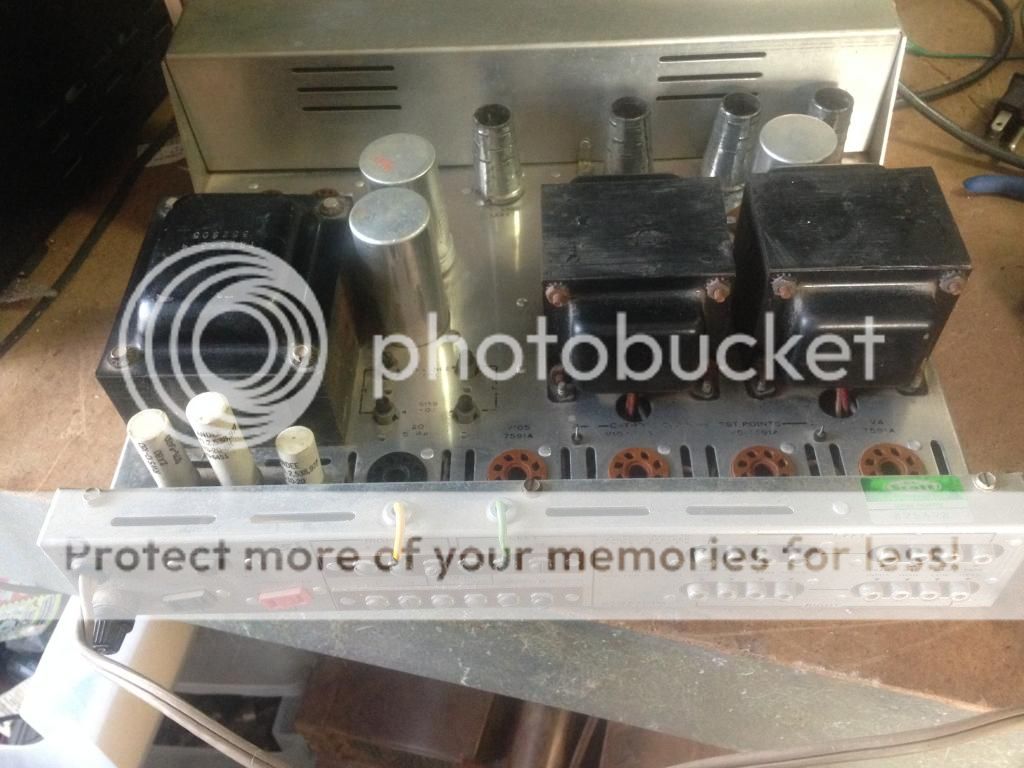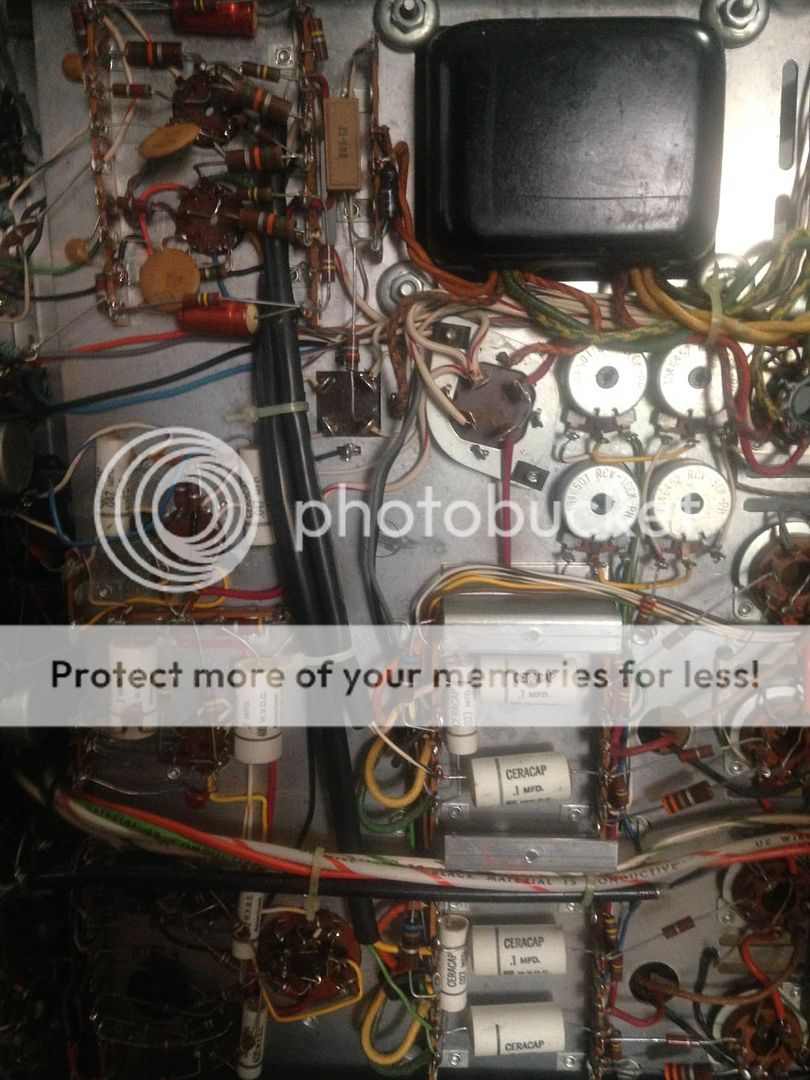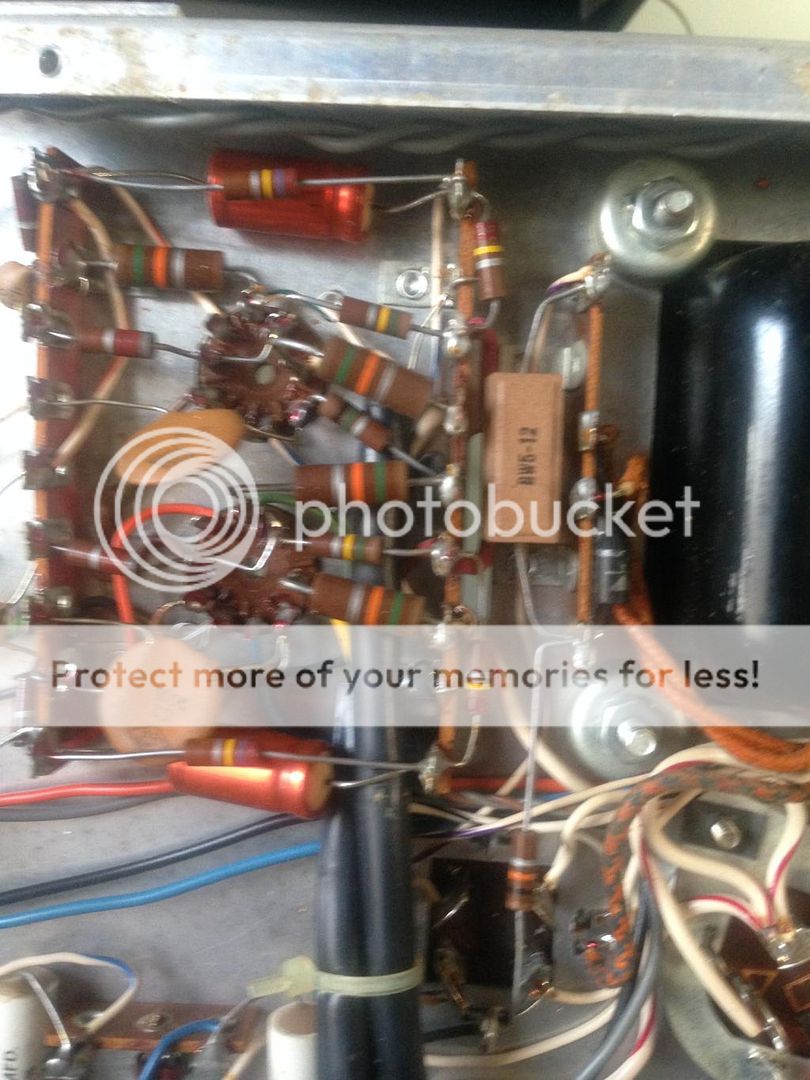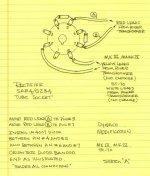This is my 1st post here just want to say hello To all .
I just scored a Scott299D i am going to bring back to life i am a novice on amps this is the first one i am going to do .but i have been restoring old hallicrafters shortwave radios including my SX42 . the amp doesnt have any tubes this is where i start asking questions what is the best tubes for the preamp stage it uses 12ax7's i have a new gz34s rectifier tube but the rest not sure about . i also plan on recapping agian this is different from radios LOL what type of caps? i do have a lot of orange drops in stock and also 1 watt flameproof metal oxide resistors .i also have a variac. should i try to just put tubes in it first and bring it up slowly on the variac to see what i have to work with ????i need to get a schematic also not good enough to work without one lol. i cant wait to get started on this amp and play my empire turntable and teac reel to reel with it . i appreciate any info and pointers
I just scored a Scott299D i am going to bring back to life i am a novice on amps this is the first one i am going to do .but i have been restoring old hallicrafters shortwave radios including my SX42 . the amp doesnt have any tubes this is where i start asking questions what is the best tubes for the preamp stage it uses 12ax7's i have a new gz34s rectifier tube but the rest not sure about . i also plan on recapping agian this is different from radios LOL what type of caps? i do have a lot of orange drops in stock and also 1 watt flameproof metal oxide resistors .i also have a variac. should i try to just put tubes in it first and bring it up slowly on the variac to see what i have to work with ????i need to get a schematic also not good enough to work without one lol. i cant wait to get started on this amp and play my empire turntable and teac reel to reel with it . i appreciate any info and pointers
Metal oxide resistors are a signal path no/no. Metal film resistors are fine in grid to ground positions, bias test points, and in NFB loops. Being both non-inductive and non-metallic, carbon composition parts are superior in grid stopper positions. Carbon film and Mills non-inductive parts are good in the other positions.
I suggest the clean and quiet Sovtek 12AX7LPS in the phono section. I suggest the "reissue" Mullard variant for the "line" section. There are several reliable tube dealers you can deal with. My go to guy is Jim McShane and I suggest you discuss your needs with him.
716P series "Orange Drops" are good for audio. Save any other series parts for "boat anchors". In order to hear the amp, not the caps., mix the dielectric types up. Soviet surplus K40 paper in oil (PIO) caps. are a good value. Between the 716Ps and the K40s, you should do fine.
Quiet a few current production GZ34/5AR4s are prone to arcing. I've uploaded a graphic which shows how to place SS diodes in series with the rectifier tube's plates. That tweak solves the arcing problem and is completely transparent. The graphic shows 1N4007s, but I strongly suggest you use the MUCH quieter UF4007.
I suggest the clean and quiet Sovtek 12AX7LPS in the phono section. I suggest the "reissue" Mullard variant for the "line" section. There are several reliable tube dealers you can deal with. My go to guy is Jim McShane and I suggest you discuss your needs with him.
716P series "Orange Drops" are good for audio. Save any other series parts for "boat anchors". In order to hear the amp, not the caps., mix the dielectric types up. Soviet surplus K40 paper in oil (PIO) caps. are a good value. Between the 716Ps and the K40s, you should do fine.
Quiet a few current production GZ34/5AR4s are prone to arcing. I've uploaded a graphic which shows how to place SS diodes in series with the rectifier tube's plates. That tweak solves the arcing problem and is completely transparent. The graphic shows 1N4007s, but I strongly suggest you use the MUCH quieter UF4007.
Attachments
Ditto on the resistors and caps. The K40Y9s are nice but a little on the large side so allow for extra room around them. I personally prefer the JJ ECC83S in similar preamp stages as it has a slightly warmer sound than the Sovtek. Do not believe the advertizing on the new production Mullard 12AX7. They are not really any quieter. I show at least a 2 db higher noise level in them compared to the JJs.
Have fun with the rebuild.
Have fun with the rebuild.
Replace any rectifier tubes with silicon temporarily.
I am going to disagree on this one, silicon might exceed the voltage rating of the power supply caps. The 5AR4 will do two things, firstly it has a 100R (from memory) plate resistance so the voltage drop across it will be far greater than silicon. And it also will have a delay on the B+ so the power tubes can warm up and start conducting.
The only way I would advise this is with the use of the variac and keep the voltage below the capacitors rating.
When reforming caps in antiques, I've had very good luck with a combination of several things:
I remove all the tubes, including any rectifiers, and replace any rectifiers temporarily with silicon. For the usual octal rectifiers I keep an ancient "tube replacement" handy - plugs right in.
The variac needs sensitive metering of both current draw and output voltage.
I hang a scope across the first cap, and sometimes use its second channel to look at downstream caps, although this is almost never necessary. Once you've gotten a feel for the way the reforming looks by seeing residual ripple, you'll be much more confident about your rate of increasing voltage. Ripple decreases as the cap re-forms.
Allow a *lot* of time. Several hours is not extreme. You can't rush the "cooking" process.
Explore a little above the caps' voltage rating. It will almost certainly be exposed to this in real usage at modern line voltages, so prepare 'em as much as you feel comfortable about, observing primary current draw closely.
The ability to confidently monitor current draw is one reason to remove all tubes. The other reason is that it's not great for them to pull much current without enough heater voltage.
That's my technique, and I'm sure there are others. All good fortune,
Chris
I remove all the tubes, including any rectifiers, and replace any rectifiers temporarily with silicon. For the usual octal rectifiers I keep an ancient "tube replacement" handy - plugs right in.
The variac needs sensitive metering of both current draw and output voltage.
I hang a scope across the first cap, and sometimes use its second channel to look at downstream caps, although this is almost never necessary. Once you've gotten a feel for the way the reforming looks by seeing residual ripple, you'll be much more confident about your rate of increasing voltage. Ripple decreases as the cap re-forms.
Allow a *lot* of time. Several hours is not extreme. You can't rush the "cooking" process.
Explore a little above the caps' voltage rating. It will almost certainly be exposed to this in real usage at modern line voltages, so prepare 'em as much as you feel comfortable about, observing primary current draw closely.
The ability to confidently monitor current draw is one reason to remove all tubes. The other reason is that it's not great for them to pull much current without enough heater voltage.
That's my technique, and I'm sure there are others. All good fortune,
Chris
I personally prefer the JJ ECC83S in similar preamp stages as it has a slightly warmer sound than the Sovtek.
One plus is the LPS Sovtek has is the spiral wound heater/filament which improves hum issue. If you want a tube that is warmer the Genalex B759 reissue is very nice sounding IMHO, has the spiral wound heater/filament, and is warmer toned by a good bit as compared to the LPS.
I don't believe the JJ has that feature.
Do not believe the advertizing on the new production Mullard 12AX7. They are not really any quieter. I show at least a 2 db higher noise level in them compared to the JJs.
I believe the "quiet" referred to is related to the short plate tube's reduced microphonic tendencies, not so much the internally generated noise.
Last edited:
Hi...The "S" on the end of the JJ tube designation means it is a spiral filament. I like the low heater noise of the ECC83S and the ECC803S. The gold pin versions don't seem to be any quieter but may be less prone to socket oxidation particularly if you use gold plated socket pins.
Hi...The "S" on the end of the JJ tube designation means it is a spiral filament. I like the low heater noise of the ECC83S and the ECC803S. The gold pin versions don't seem to be any quieter but may be less prone to socket oxidation particularly if you use gold plated socket pins.
Yep, I forgot that - thanks for updating me!
One thing about the gold plating is the plating makes the pins a tad thicker which takes up for some socket wear; when the gold pin tube is going in vintage gear that can be a real help.
Hey guys Thanks for all the replies i am going to take advice on tubes but i found this while searching around and researching tubes. not sure if any one has used these electro-harmonix 7591A i can get a quad set for 90 bucks ???????
i also came across TUNG-SOL 12AX7 ?????.
I got amp today a i am going to start working on it this evening . will post some pictures .
i also came across TUNG-SOL 12AX7 ?????.
I got amp today a i am going to start working on it this evening . will post some pictures .
The EH 7591 is the tube to use. IIRC, JJ also makes a 7591, but all of JJ's Octal production has demonstrated serious reliability issues.
The "reissue" TungSol is nice. New Sensor owns the rights to several famous brands, among which are Mullard and TungSol. NOS 'X7s of those brands, if available, is expensive. The "tone" you are trying to get will influence your choice of variety. The "reissue" Mullard 'X7 exhibits some of the famous mid-range accent. OTOH, the TungSol "reissue" exhibits a bit of the NJ "chime".
I previously suggested the Sovtek 12AX7LPS for the phono section, as properly culled specimens of that variant exhibit superior noise factors and the variant's voice is essentially neutral. JMO, tweak voicing in the line stage, where it will influence all signal sources.
The "reissue" TungSol is nice. New Sensor owns the rights to several famous brands, among which are Mullard and TungSol. NOS 'X7s of those brands, if available, is expensive. The "tone" you are trying to get will influence your choice of variety. The "reissue" Mullard 'X7 exhibits some of the famous mid-range accent. OTOH, the TungSol "reissue" exhibits a bit of the NJ "chime".
I previously suggested the Sovtek 12AX7LPS for the phono section, as properly culled specimens of that variant exhibit superior noise factors and the variant's voice is essentially neutral. JMO, tweak voicing in the line stage, where it will influence all signal sources.
Here are a few pics of the amp it is very nice original condition and the front panel is nice no scratches or marks of any kind . i removed the bottom and it appears untouched and unmolested



in the last picture there is a orange cap is this oil filled also near the power supply there are 2 diodes are these the ones i have read to replace ???



in the last picture there is a orange cap is this oil filled also near the power supply there are 2 diodes are these the ones i have read to replace ???
This is the 1964 299D schematic. Check your unit's serial number to see if the earlier version is what you need to use.
An obvious difference between the 2 versions is how the negative rail is set up. The early version bridge rectified the rail, while the later version uses FWCT. Your 2 diode remark suggests the later version.
I think the orange wrapped parts are 'lytics.
An obvious difference between the 2 versions is how the negative rail is set up. The early version bridge rectified the rail, while the later version uses FWCT. Your 2 diode remark suggests the later version.
I think the orange wrapped parts are 'lytics.
Watch out about the polarity of the bias supply electrolytic which from memory is positive common. More than one person has been tripped up by this issue..
The ceracaps are extremely unreliable in my experience unfortunately, but start by replacing only those that prove to be bad. Check and only replace bad resistors.
Ceramic disp caps are a good candidate for replacement. (They make measurable distortion in some cases)
Finally FWTW I think the 299D was the best sounding of the 299 series, followed by the A. I've owned them all at one point or another.
The ceracaps are extremely unreliable in my experience unfortunately, but start by replacing only those that prove to be bad. Check and only replace bad resistors.
Ceramic disp caps are a good candidate for replacement. (They make measurable distortion in some cases)
Finally FWTW I think the 299D was the best sounding of the 299 series, followed by the A. I've owned them all at one point or another.
Watch out about the polarity of the bias supply electrolytic which from memory is positive common. More than one person has been tripped up by this issue.
Uh huh!
 A negative rail has a positive ground.
A negative rail has a positive ground.The cap is a multi-section can with a positive as opposed to negative common - more insidious and out to get the unwary - I know of several people who made this mistake. No one (afaik) currently makes a suitable replacement for this component. You may have to remove it, gut it and install modern caps inside.
The other approach is to cut the wires away from the bad cap, leave it there for cosmetic purposes, and place appropriate axial/radial caps underneath the chassis. The advantage for that approach is that you can place each separate cap physically closer to where it actually needs to be. Same goes for the main supply multi-section cap. Modern electrolytics are small enough so that this approach has an excellent chance of working.
The other approach is to cut the wires away from the bad cap, leave it there for cosmetic purposes, and place appropriate axial/radial caps underneath the chassis. The advantage for that approach is that you can place each separate cap physically closer to where it actually needs to be. Same goes for the main supply multi-section cap. Modern electrolytics are small enough so that this approach has an excellent chance of working.
This is the technique I used in my HH 299A, worked great
- Status
- This old topic is closed. If you want to reopen this topic, contact a moderator using the "Report Post" button.
- Home
- Amplifiers
- Tubes / Valves
- Scott 299D
